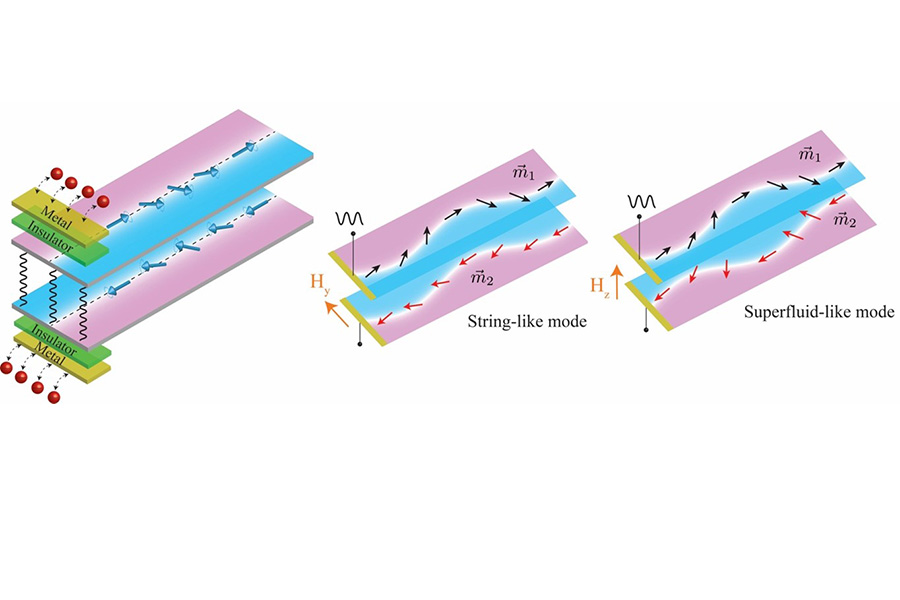Purdue ECE research aims to transform the information processing and storage industries

Research from the Purdue University Elmore Family School of Electrical and computer engineering has been published in the journal Physical Review Letters. Grad student Mohammad Mushfiqur Rahman led the work on the paper, entitled “Electrically Active Domain Wall Magnons in Layered van der Waals Antiferromagnets.” Rahman is a student of Pramey Upadhyaya, assistant professor of electrical and computer engineering.
The effort to incorporate electron’s spin degree of freedom into conventional electronics has remained a burgeoning field for the past few decades. While harnessing spins by exploiting their collective eigen-excitations promise ultralow dissipation information processing, wave-interference-based computing, and robust tunability features, the field still has to overcome several major obstacles before becoming compatible with the existing CMOS technology. One such challenge is the nanoscale, efficient generation of spin waves.
In this work, Purdue ECE researchers tackle this challenge by harnessing the inherent coupling between spin and charge degrees of freedom in atomically thick magnets-- a new class of magnetic system where confinement effects naturally give rise to pronounced spin-charge coupling. Similar to the way graphene revolutionized electronics, these tiny magnets have the potential to transform the modern information processing as well as the storage industry.
Interestingly, different from conventional ferro- and antiferromagnets, the symmetries in layered van der Waals (vdW) antiferromagnets engender unique dynamical modes which can be controlled by the nearby charge environment. Exploiting these features, this research demonstrate the electrical excitation of spin waves along the domain walls in such magnets.
Rahman says this provides a potential pathway to solving several existing challenges faced by the Spintronics community, such as local and low-energy excitation of magnons along nanoscale channels, robust controllability features, etc.
“Our work can potentially extend the ability of vdW Spintronics devices to enable a platform for electrically probing coherent spin dynamics as well as various emergent and difficult to probe magnetic phenomena,” says Rahman. “We demonstrate that the elementary collective excitations of magnetic domain walls-- a thin wall connecting two oppositely oriented domains-- in van der Waals (vdW) layered antiferromagnets (AFM) can be electrically activated, providing a path to create nanoscale, tunable, and low-dissipation channels for transporting information carried by spins.”
In addition to Rahman and Upadhyaya, the following people contributed to the research:
- Avinash Rustagi, former postdoctoral researcher at Purdue University, currently PTD Module and Integration Yield Engineer for Intel Corporantion, and
- Yaroslav Tserkovnyak, professor in the Department of Physics and Astronomy at the University of California, Los Angeles

Extended Summary:
The effort to incorporate electron’s spin degree of freedom into conventional electronics has remained a burgeoning field for the past few decades. While harnessing spins by exploiting their collective eigen-excitations promise ultralow dissipation information processing, wave-interference-based computing, and robust tunability features, the field still has to overcome several major obstacles before becoming compatible with the existing CMOS technology. One such challenge is the nanoscale, efficient generation of spin waves.
In this work, we tackle this challenge by harnessing the inherent coupling between spin and charge degrees of freedom in atomically thick magnets-- a new class of magnetic system where confinement effects naturally give rise to pronounced spin-charge coupling. Similar to the way graphene revolutionized electronics, these tiny magnets have the potential to transform the modern information processing as well as storage industry. Interestingly, different from conventional ferro- and antiferromagnets, the symmetries in layered van der Waals (vdW) antiferromagnets engender unique dynamical modes which can be controlled by the nearby charge environment. Exploiting these features, we demonstrate the electrical excitation of spin waves along the domain walls in such magnets. This provides a potential pathway to solving several existing challenges faced by the Spintronics community, e.g., local and low-energy excitation of magnons along nanoscale channels, robust controllability features, etc.
Our work can potentially extend the ability of vdW Spintronics devices to enable a platform for electrically probing coherent spin dynamics as well as various emergent and difficult to probe magnetic phenomena.
